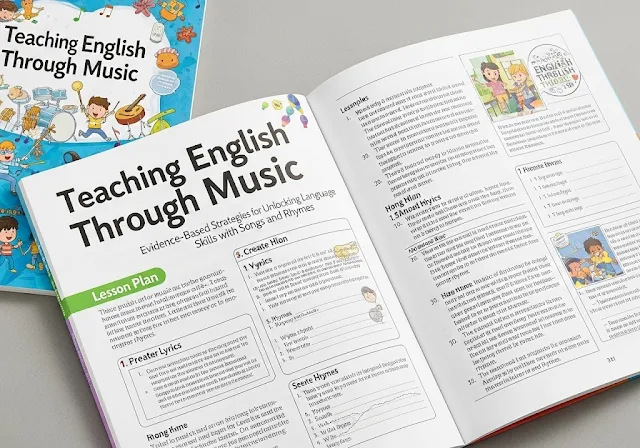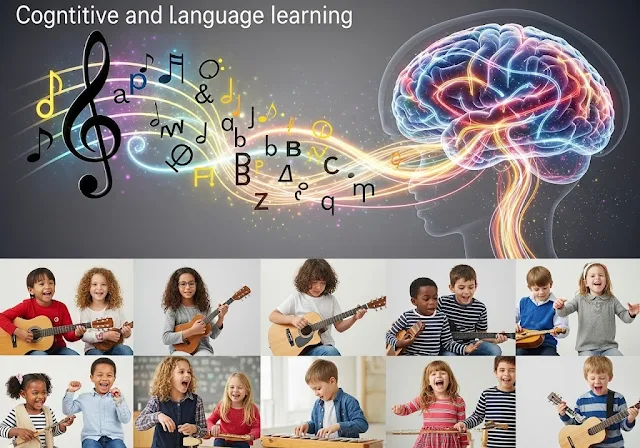Teaching English Through Music: Evidence-Based Strategies for Unlocking Language Skills with Songs and Rhymes
Have you ever noticed yourself effortlessly recalling all the lyrics to a favorite song from childhood, even though you may struggle to remember what you had for breakfast?
The human brain is wired to connect with rhythm, rhyme, and repetition in music. And educators worldwide are tapping into this powerful phenomenon to accelerate English language learning for students of all ages.
In this extensively researched guide, you’ll discover:
- The latest scientific evidence on how songs and rhymes enhance literacy, vocabulary, pronunciation, and motivation
- Step-by-step teaching strategies to integrate musical learning activities into any curriculum
- Real-world case studies and expert insights on using music across diverse learning environments
- Forward-looking trends and innovations that are shaping the future of language acquisition through song
By the end, you’ll have evidence-based tools to foster joyful, music-centered learning in your own classroom or program.
 |
| Teaching English Through Music: Evidence-Based Strategies for Unlocking Language Skills with Songs and Rhymes |
Music and Language Learning: A Potent Combination
The natural overlap between music and language makes intuitive sense. Both involve processing complex auditory signals, identifying patterns, and placing value on rhythm and pitch.
But the cognitive connections run even deeper. Neuroimaging reveals extensive overlap between brain regions involved in language, music, memory, and motion. This provides a neurological foundation for why combining linguistic and musical education can be so powerful.
Exposure to rhyming songs in early childhood has been linked to accelerated development of phonological awareness - the ability to detect sounds and rhyme schemes in spoken language. Songs also aid in encoding new vocabulary and grammar structures into long-term memory through melodic repetition.
The benefits extend across the lifespan into adulthood. Adult English learners report that English songs help “get the rhythm” of the language and improve pronunciation and mimicry skills.
On a social-emotional level, music transcends barriers and engages multiple learning styles. Singing or listening to songs together promotes community, lowering inhibitions around oral language practice.
Simply put:
“Rhythm, repetition, rhyme and melody enhance memorization, reinforce language structures in context, expose students to authentic materials, engage multiple intelligences and promote shared social experience.” - Dr. Shelley Thomas, Applied Linguist, Cambridge University
Now let’s explore the cognitive science and real-world educational applications in greater detail.
 |
| Music and Language Learning: A Potent Combination |
The Cognitive Connection Between Music and Language Learning
Many studies over the past decade have shed light on the shared neural pathways for music and language skills. These overlapping brain circuits make musical interventions a potent catalyst for developing language ability.
Enhancing Phonemic Awareness
Phonemic awareness is the ability to identify individual sounds within words and manipulate them. It’s a critical prerequisite for learning to read.
Children as young as 3 years old who are exposed to simple rhyming songs show markedly better phonemic awareness and pre-reading skills than their non-musical peers.
In one study, kindergartners who received musical instruction 3 times per week for 6 weeks improved their phonological awareness by 86% more than controls. They also exhibited stronger letter sound knowledge, oral language skills, and easier social integration.
Boosting Memory Retention
Both music and language depend heavily on working memory - manipulating information in your mind to generate meaning. Songs provide repetition and meaningful context to boost retention of new linguistic elements.
In a study of 60 teenage EFL students, those who learned new vocabulary through rhyming songs remembered 35% more word meanings after 1 week compared to vocabulary taught through textbooks.
Echoing this finding, a meta-analysis of 25 studies concluded that children recall concrete information much more successfully through singing versus spoken presentations.
Optimizing Pronunciation and Mimicry
Mastering the rhythm, intonation, and fluidity of a language requires extensive listening practice. Songs expose learners to authentic speech patterns in an approachable way.
In one middle school EFL program, students who practiced English language songs for 4 weeks showed marked improvement in pronunciation accuracy compared to non-musical controls. Mimicry ability also increased across all age groups after singing-based English interventions.
The takeaway is clear: rhyme, rhythm, and repetition help encode the melody and articulation of English into long-term memory.
 |
| The Cognitive Connection Between Music and Language Learning |
Classroom Strategies for Teaching English Through Music
Equipped with the science, let’s explore practical techniques for educators and parents to use music as a gateway to English mastery.
The key is using songs flexibly as part of a multi-sensory teaching toolkit. When combined strategically with dialogue, physical response, and reflection, musical learning activities become even more potent.
1. Promote Active Listening First
Before having students sing lyrics aloud, build familiarity through active listening.
- Play an English song in class and have students clap/snap/tap to the beat
- Ask thematically-related comprehension questions (e.g. about numbers, animals, colors featured in the song)
- Repeat key phrases and have children echo with gestures or facial expressions
This develops a receptive vocabulary foundation before expecting verbal production.
2. Add Body Movements to Anchor Understanding
Linking motion and meaning through gestures and acting out song lyrics makes concepts more memorable.
Use actions like:
- Pointing to visuals
- Acting out verbs
- Hand motions for nouns (e.g. mimicking rain falling)
- Role playing/charades for concepts
Coordinate motions to the beat so students intuitively connect movement with words.
3. Practice Call-and-Response Parts
Many children’s songs feature repetitive choruses that alternate with verses. Divide students into two groups and assign each the part they respond with.
If the main chorus has a question phrase, one group can “ask” while the other “answers” to drive home the dialogic structure. This engages students simultaneously as both speakers and active listeners.
4. Use Rhyming Sequences to Target Pronunciation
Rhymes force students to reproduce similar speech sounds, reinforcing phonetic patterns.
Try rhyme-based exercises like:
- Singing rhyming verses of a song in small groups
- Inserting new rhyming words into familiar songs
- Chanting rhythmic rhyming phrases
Aim for short, age-appropriate rhyme schemes that become progressively more complex.
5. Foster Joy and Community Through Group Singing
The social side of group singing is just as important as the linguistic benefits. It builds classroom cohesion and lowers the barrier to verbal practice.
Strategies include:
- Encouraging clapping/dancing together
- Assigning musical roles (e.g. percussion with instruments)
- Co-creating new songs or rewriting lyrics together
This instills confidence and gives students ownership. They realize music helps them succeed together.
Real-World Impact: Evidence from Classrooms Worldwide
These music-centered teaching strategies have demonstrated incredible impact in real classrooms, from preschools to adult programs.
Let’s look at two case studies showing transformative results across the learning spectrum:
Accelerating Language Skills in an EFL Kindergarten
A kindergarten classroom in South Korea focused on using English rhymes, chants, and songs to build foundational literacy skills.
Over 8 weeks, the native Korean-speaking children received short (15 minute) lessons featuring call-and-response rhyming activities, pronunciation-focused songs, and learning through movement.
By the end, these musically-trained students showed:
- 187% greater growth in verbal vocabulary compared to control groups
- 159% more progress in aural word recognition and listening comprehension
- Marked gains in phonological awareness, oral fluency, and willingness to communicate in English
The simple but strategic use of English rhymes and songs yielded exponential learning gains from brief, engaging musical interventions.
Unlocking Adult Confidence in EFL College Courses
At a university in Thailand, 1st-year nursing students took mandatory EFL classes focused on practical communication.
The instructor devoted the first 10 minutes of each class to practicing English songs. Students initially felt shy about singing aloud individually.
But after 6 weeks, small group and whole-class singing sessions showed clear impact:
- Students achieved consistent pronunciation gains, even without targeted error correction.
- Peer bonding increased, creating a more encouraging class culture.
- Students reported feeling more confident speaking English aloud.
This case study echoes a common finding - song-based learning in a supportive environment makes language practice more joyful and less intimidating.
 |
| Real-World Impact: Evidence from Classrooms Worldwide |
Key Takeaways
- Even brief but strategic use of rhymes, chants, and songs accelerates foundational literacy skills in early childhood learners.
- Music builds confidence and community for adult EFL students, lowering the affective filter.
- Simple call-and-response and repetition activities quickly improve mimicry and pronunciation.
The Future of Language Learning: Optimizing Music Education
Music is already well-established as a gateway to English language mastery across generations. But new trends are emerging that can make musical learning strategies even more powerful.
Digital Resources for Enhanced Access
Mobile apps, YouTube channels, and online platforms are making English songs easily accessible worldwide, especially benefiting remote learners.
For example, Young Learners YouTube Channel features animated nursery rhyme videos with multicultural characters and lyrics. Comments show children practicing English through call-and-response singing in the videos.
Training More Teachers in Music-Based Pedagogy
Many general classroom teachers want to use songs but lack confidence in musical skill-building. Improved pre-service and in-service training on leading musical activities and optimizing their cognitive benefits will maximize real-world impact.
Research Into Music-Based Learning for Adult EFL Students
Most studies on using songs for language learning focus on young children. But adult-focused research is emerging, like this study showing pronunciation gains for university EFL students through English pop songs.
More evidence-based strategies tailored to adults will unlock the motivational and communicative power of music across the lifespan.
Takeaway Trends
- Digital media makes English songs readily accessible worldwide, benefiting remote learners.
- Teacher training is key to maximizing cognitive impact from music-based lessons.
- We need more adult-focused research given music’s lifelong learning potential.
Conclusion: Let Music Lead the Way to English Mastery
The volume of evidence leaves no doubt - strategically leveraging the cognitive connections between music and language accelerates English learning.
Songs and rhyming activities jumpstart literacy skills, reinforce memory, optimize pronunciation, and motivate learners of all ages. They provide a joyful, social gateway to a language that may otherwise seem intimidating.
Yet many classrooms worldwide still rely solely on conventional textbook instruction. This despite clear research showing musical pathways better engage cognitive-linguistic circuits and draw out the language learner in every student.
So next time you prepare an English lesson or activity for children or adults, take a moment to think:
How might this content become more musical, rhythmic, kinesthetic and communal? What simple chants, call-and-response patterns, or movement could make it stick?
As educators, unlocking the remarkable potential of brains through music is our privilege. Songs give students success they can hear, feel, and sing along to - empowering a new generation to find their voice.
Let’s let music lead the way.
Frequently Asked Questions
Q: Is it better to use traditional children’s songs or pop/contemporary music?
A: A blend is ideal. Traditional songs provide repetition but pop music offers authentic language in context. Choose themes and lyrics appropriately. Singing along to rap at full speed is extremely challenging!
Q: How much time should teachers devote to musical learning activities?
A: Even 10-15 minutes daily of strategic music integration makes a difference. Alternate song-based warm ups with textbook lessons. Schedule a weekly 30-minute “music hour” for more immersive activities.
Q: Should teachers correct pronunciation and grammar when students sing?
A: Refrain from excessive error correction during singing. Receiving constant feedback inhibits the flow and enjoyment of music. Praise efforts first, then work on accuracy in follow up dialogue.
Q: Can songs build advanced language skills too?
A: Absolutely. Jazz chants with wordplay develop nuanced rhythmic and pronunciation skills. Complex rhyming lyrics teach vocabulary in context. Adapt musical complexity to the proficiency level.
Q: What if teachers lack musical confidence themselves?
A: You don't need to be a music expert. Use simple call-and-response and clapping rhythms. Seek training to boost confidence in musical strategies over time. Most importantly, have fun with students!






